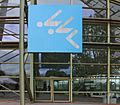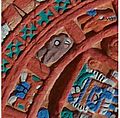Pictogram facts for kids
A pictograph is like a small picture or drawing. It tells a story or gives information without using words. Think of them as tiny visual messages! People use pictographs all the time today. They are great because anyone can understand them, no matter what language they speak. This makes them perfect for places where many different people gather.
Pictographs are also super helpful when you need to understand something quickly. Seeing a picture is often faster than reading words. This is why you often see pictographs in emergency situations. For example, they show you where the emergency exit is.
Common places where you find pictographs include road signs, airports, and train stations. They are also used for warning signs to keep us safe.
Contents
What Are Pictographs?
A pictograph (sometimes called a pictogram) is a picture that represents a word or an idea. It is a way to communicate without using letters or numbers. Imagine drawing a picture of a sun to mean "sun" or "day." That's a pictograph!
These simple drawings are understood by many people. This is true even if they speak different languages. This makes them a very powerful tool for sharing information.
Why Are Pictographs Useful?
Pictographs are useful for several reasons. First, they are universal. A picture of a person walking can mean "pedestrian crossing" in many countries. You don't need to translate it.
Second, they are fast. Your brain can understand a picture much faster than it can read a sentence. This is very important in places like airports or train stations. You need to quickly find your way or understand a warning.
Third, they save space. A small drawing can convey a lot of information. This is helpful on road signs or small buttons.
Pictographs Through History
Pictographs are not new. People have used them for thousands of years! Early humans drew pictures on cave walls. These drawings told stories about hunting or daily life. They were some of the first ways humans communicated in writing.
Ancient civilizations also used pictographs. The ancient Egyptians used hieroglyphs. Many hieroglyphs were pictographs. For example, a picture of an owl meant "owl." The Aztecs and Mayans in Central America also used pictographs in their writing systems. These systems helped them record history and important events.
Over time, pictographs slowly changed into more complex writing systems. These systems used symbols that represented sounds, not just objects. But the idea of using pictures to communicate never went away.
Modern Pictographs
Today, pictographs are everywhere. They help us navigate our daily lives. Think about the signs you see in public places:
- A picture of a knife and fork means "restaurant."
- A picture of a person in a wheelchair means "accessible."
- A picture of a phone means "telephone."
These modern pictographs are designed to be clear and easy to understand. They are often simple black-and-white drawings. They are used in many different fields. This includes sports, travel, and safety. For example, the Olympic Games use pictograms for each sport. This helps people from all over the world understand the events.
Pictographs are a great example of how simple pictures can share big ideas. They connect people across languages and cultures.
Images for kids
-
Ojibwa pictographs on cliff-face at Agawa Rock, Lake Superior Provincial Park of a boat and Mishipeshu, an animal with horns, painted with red ochre
-
Several prehistoric engravings can be found around La Silla Observatory.
-
Native American Pictographs from the Great Gallery, Horseshoe Canyon, Canyonlands National Park
-
Pictograph from 1510 telling a story of coming of missionaries to Hispaniola
-
This highly influential pictogram design was introduced at the 1972 Munich Olympics, although pictograms first began to appear in the games at Tokyo in 1964.
-
British Rail passenger safety pictographs at the end of the platform at Meols railway station
-
Water, rabbit, deer pictographs on a replica of an Aztec Stone of the Sun
See also
 In Spanish: Pictograma para niños
In Spanish: Pictograma para niños










